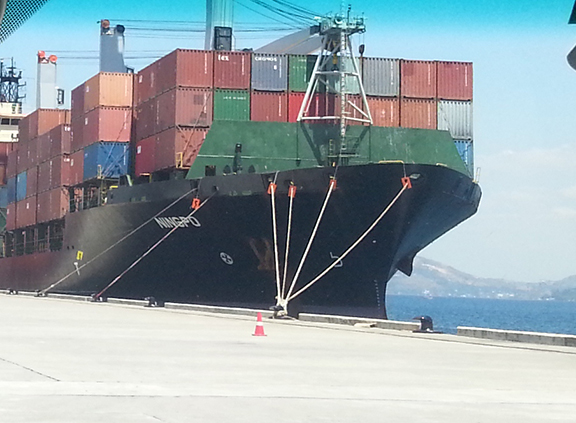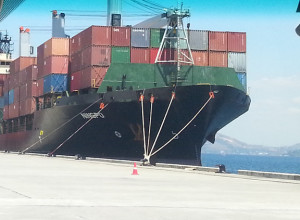

Curbing capacity expansion plans for Manila ports and providing incentives for greater use of Subic and Batangas ports are doable short-term plans the government can undertake to create a seamless transport system for Metro Manila and nearby areas, recommends Japan International Cooperation Agency (JICA).
Due to increasing congestion at Manila ports, “for the short-term, incentives to encourage shippers to use the ports of Subic and Batangas as well as placing a capacity limit for future expansion of Manila ports are necessary,” JICA said in its recently released “Roadmap for Transport Infrastructure Development for Metro Manila and Its Surrounding Areas (Region III and Region IV-A)” report prepared by Almec Corporation.
According to the study, “the main challenge to the development of the ports of Manila is tempering its continued growth, so that more cargo can flow into Subic and Batangas.”
JICA helped build the Subic and Batangas ports.
As for medium- to long-term strategies, “industrial development should be promoted in Region III and Region IV-A, in coordination with port functions, and at the same time, changing roles of Manila ports and port areas from simple cargo handling facilities to multi-purpose urban use should be pursued,” the report added.
“It should also be considered that port and port areas be made attractive for more value added urban development.”
It added that the success of Manila ports has “enabled the economic growth of the region, but it also resulted in high volume of truck container traffic in the metropolis, especially in the old city of Manila.”
The thinking that trucks are the major cause of road congestion has led to policies such as truck bans that, according to JICA, “caused underutilization of freight vehicles that in turn has had the perverse effect of inducing more trucks than necessary.”
On calls for Manila shutdown
JICA noted that “traffic authorities favor the closure of the Manila ports partially, if not totally.” And the clamor to “phase out” the ports of Manila (North Harbor, South Harbor, Harbour Center, and Manila International Container Terminal) has been supported by some business groups, but “without examining the implications.”
But the paper said the phaseout of the ports of Manila “is not tenable in the short- to medium-term period” because the total capacity in the two alternate ports (Batangas and Subic) “is insufficient to handle all the container traffic (in Manila ports)–which in 2012 exceeded the 2.7 million TEUs mark.”
The study identified the two main arguments for calls for a phaseout of Manila ports: traffic decongestion in Manila, and improved productivity for Batangas and Subic ports.
“The first may be true, for roads leading to/from the ports,” the report said, citing a survey made in 2011 that showed container trucks accounting for about 20% of traffic volume on R-10. On other urban streets, however, trucks are not as prevalent mainly because of the truck ban.
The study said that due to the need to distribute freight, trucks will not disappear from city streets simply because the ports have been closed.
Moreover, with less than 10,000 registered heavy trucks in the National Capital Region (NCR), they represent less than 1% of the metropolitan’s vehicle population.
Batangas, Subic ports overdesigned?
On the second argument that closing Manila ports will increase utilization of Batangas and Subic ports, JICA contended this provides a stronger argument, “albeit it may seem to justify an error.”
In theory, transferring more cargoes from Manila to the two ports will diminish the number of trucks on urban roads. JICA even commissioned a study in 2012 to formulate measures to shift cargoes away from Manila to support the goal of making the two ports productive.
But even though Batangas and Subic ports are now fully operational, “their traffic volumes are way below their original forecasts or initial expectations,” the JICA study reported.
The two ports have a combined capacity of 1 million twenty-foot-equivalent units (
TEUs) annually, but their current utilization is less than 5%, the report noted.
This despite the government going to the extent of borrowing more than US$240 million from JICA to develop the two ports and supporting traffic around them by building the Star Expressway and the Subic-Clark Expressway.
“Either these ports were overdesigned from the outset, or justified on illusory demand, or simply unattractive to shipping lines,” it said by way of explanation.
The study’s earlier draft recommended more drastic measures: reducing port charges in the outlying ports as an incentive, aside from an administrative order mandating the cargo transfers.
Lukewarm market response
According to JICA, while encouraging such a shift in the flow of port-bound cargoes appears “logical,” especially for shippers in the CALABARZON (Cavite, Laguna, Batangas, Rizal and Quezon) area where 1,000 economic zone locators are situated, the market is not responding.
“Most of their cargoes still flow through the ports of Manila,” the study stated.
“More ship calls in the latter mean shorter time-to-market, which shippers want and are prepared to pay. As long as the international shipping cartels prefer to call Manila, there is very little incentive for shippers to move their cargo to the ports of Batangas and Subic where ship calls are few and far in between. This is the classic chicken-and-egg situation. About 23 shipping companies call on Manila whilst Batangas can only claim one ship call a week and Subic claims two.”
(It should be noted that since the JICA study was released, a few more shipping lines are now calling Subic and Batangas, largely due to the need to avoid congestion caused by the Manila truck ban. While the Manila truck ban was recently lifted, PortCalls sources said its effect negative effects will linger for a few more months.)
A sampling survey done under the 2012 JICA port decongestion study may indicate the reason for shippers’ reluctance to shift cargo to Subic and Clark: It showed that more than 50% of the tonnage unloaded at the port of Batangas and more than 60% of cargoes from South Harbor and MICT were destined for points within Metro Manila. Only 10% and 13%, respectively, went to consignees south of Manila, the study said.
“If these were representative of the whole, then forcing a shift away from the ports of Manila cannot be justified,” it noted, adding that the same survey showed that shipments through the port of Subic were mainly coming from the north of the National Capital Region.
“The implication is that its (Subic) future relies less on diversion from Manila,” the report concluded.
The study conducted from March 2013 to March 2014 has been approved by the National Economic and Development Authority Board, chaired by President Benigno Aquino III. It was conducted by JICA in coordination with the Department of Transportation and Communications, Department of Public Works and Highways, Metropolitan Manila Development Authority, and other agencies. – Roumina Pablo




